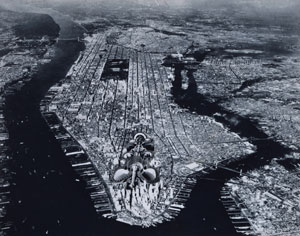by: Lisa Delgado
Exhibition: Dreamland: Architectural Experiments since the 1970s
Location: Museum of Modern Art, through 03.02.09
New York City has always been a magnet for dreamers, and architects are no exception. In the 1960s and 1970s, a wave of young architects such as Raimund Abraham, Hans Hollein, Hon. FAIA, and Rem Koolhaas, took inspiration from the cityscape to form new utopian architectural visions. On the 30-year anniversary of Koolhaas’s book Delirious New York, the Museum of Modern Art’s show “Dreamland: Architectural Experiments since the 1970s” features more than 60 drawings, collages, paintings, and models dedicated to architectural experiments for New York and beyond, whether built or imagined.
Some works evoke the fantastical realms of science-fiction, such as Hollein’s collage “Urban Renewal in New York” (1964), which depicts part of Lower Manhattan transformed into a bug-like mechanical contraption — an ironic extension of Le Corbusier’s notion of the house as a machine for living in, explained curator Andres Lepik in an interview (in the absence of explanatory text in the exhibition, a frequent weakness in an otherwise engaging show). The somber “Church of Solitude” paintings (1974–77) by Gaetano Pesce depict a structure that reverses NYC’s usual inclination to build up by plunging into the earth, far from the noise and hubbub of the city, creating an underground sanctuary where visitors (animal-like and depraved) seclude themselves.
Whimsical imaginings from the then-young firm OMA include works from Delirious New York, such as Elia and Zoe Zenghelis’s painting “Hotel Sphinx” (1975–76), a Times Square hotel that straddles two blocks (a site condition lending to its sphinx shape). Koolhaas and Madelon Vriesendorp’s “The City of the Captive Globe” (1972) also celebrates Manhattan’s grid: each block houses another architectural or artistic idea, whose warmth helps to incubate the growth of the world at the center.
The City of the Captive Globe served as one source of inspiration for the show itself, said Lepik, with its assemblage of disparate concepts. A table at the center of the room serves as a platform for a dream city, dotted with models of eclectic projects from around the world. The curve of Diller + Scofidio’s Slow House rests near the angularity of Simon Unger’s T-House, both models encompassing idealist visions of what a country retreat can be. Surrounded with LED “leaves,” a high-tech model for a new Hotel Habitat in Barcelona (by Cloud 9, Acconci Studio, Ruy Ohtake, and Enric Ruiz-Geli) simulates an electronic tree house powered with solar energy. In some models, the utopian vision is obvious, in others, less so; again, more explanatory text would have made it an even stronger show.
Lisa Delgado is a freelance journalist who has written for Oculus, The Architect’s Newspaper, Blueprint, The LEAF Review, and Wired, among other publications.








